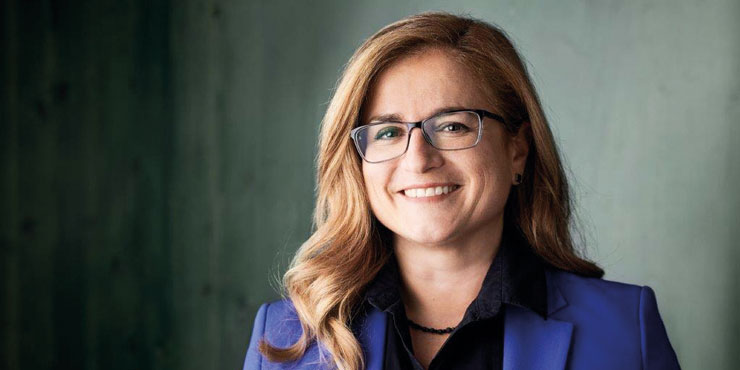"The St. Gallen quarters of the future should be lively, diverse and mixed"

In an interview with Immo! Nvest, St. Gallen City President Maria Pappa reveals where the city's development areas are and what St. Gallen should look like by 2030.
To person
Maria Pappa was born in St. Gallen in 1971 and grew up in the city. In 2016, the daughter of southern Italian immigrants was elected city councilor, and since this year the social democrat has been city president of the city of St. Gallen and heads the interior and finance department. Before that, she headed the Planning and Construction Directorate as a city councilor. Maria Pappa studied social pedagogy at the higher technical school for social work in Rorschach. Before her election, she headed the closed department of the Platanenhof youth home in Oberuzwil and later the municipal day care for school children. Before moving into social work, the commercial high school graduate worked in the accounting department of an insurance company.
Ms. Pappa, you have been the mayor of the city since the beginning of this year and are in charge of the Interior and Finance Directorate. Before that, as a city councilor, you headed the planning and construction department. How did you experience the change?
After the election of the city president and the subsequent constituent meeting of the city council, things went very quickly; there were only four weeks left for the actual change. The induction as mayor and in the new management were shaped by the pandemic: most of the contacts with employees and external parties were virtual. There were only a few representative tasks – and they were limited to video messages for online events. This shift of personal exchange into the digital space made social contacts and real relationship building more difficult. At the same time, however, I was less bound by representative tasks and was able to immerse myself in the projects and peculiarities of the new management.
Why did you decide to change management after four years of planning and construction?
The distribution of the directorates is a matter for the city council as a whole. Together we looked at all the options and decided on the most ideal. Personally, I was happy to be the head of the planning department. I would have liked to stay there. After four years you are really familiar with the projects and have accompanied many of them from the start. However, the new function as mayor is associated with many representative tasks as well as sitting on committees. A close relationship with the city chancellery is very important. The fulfillment of these additional tasks with the simultaneous management of the so broad-based planning and construction department is not feasible in terms of time.
Which projects were milestones for you as the head of planning and construction that you were allowed to support?
When I received the voting results for the redesign of Marktplatz and Bohl, a stone fell from my heart. Getting a consensus-based marketplace project through at the third attempt was intensive work. The redesign of Zürcher Strasse was also blocked for a long time. In 2018, the city parliament approved the proposed project. The redesign is to begin next year. The numerous school and care projects formed a focus. The largest project deserves special mention here: the new Riethüsli school building. This has long been expected in the quarter – in November 2020 the electorate approved it. During these four years, many important strategy papers were also worked on in the background, including living space, open space, tree and interior development strategies. Some are relevant for the revision of the building and zoning regulations. They will all shape the structural development of the city.
What projects are at the top of your agenda for you as the head of the Internal Affairs and Finance Directorate?
There are currently three current topics: I want to make St. Gallen better known as an attractive city and thus correct and improve the slightly outdated, “crumbly” image that we ourselves have of our city. When it comes to finances, St. Gallen has a solid financial basis. But it has shown a latent structural deficit for years, which is particularly evident in budgeting. The effort increases more than the income. One of the goals will therefore be to correct this structural imbalance. And finally, the cultural life of the city is close to my heart. It is important to me to implement the cultural concept that was adopted in 2020.
In 2020, a large local recreation area was opened in a densely populated area on the Burgweiher site. Are there similar land projects / land reserves that could be implemented / developed in the next few years?
The fact that we were able to make such a large green space in the middle of the city accessible to the public is a stroke of luck and certainly unique in this form. In the next few years, it will be more about residential and commercial space. The major development areas that will occupy the city in the next few years are on the one hand in the Ruckhalde. The diameter line of the Appenzeller Bahnen has freed up an area that the city wants to develop especially for residential use. On the other hand, an attractive new district is to be created in St. Fiden. The area around the train station offers a lot of potential for internal densification and an attractive redesign.
In its Vision 2030, the city council assumes that the city of St. Gallen will grow and that the population will develop into a multicultural urban society. How do you, as mayor, support this vision?
With its living space, interior development and open space strategy, St. Gallen has shown how it intends to face the future as a strong, innovative and attractive city. The real estate strategy will be added shortly. We are actively trying to convey this forward-looking image to the outside world with the “Santa” campaign. Even as director of planning and construction, collaboration and participation were important to me. With the revision of the participation regulations, the city has finally taken on a culture of participation since this year. It seems natural to me that we will continue to include those who live in this city when it comes to designing this city. Participation also means that we seek cooperation and exchange with our own canton and neighboring cantons, the municipalities and other cities and cultivate synergies.
What exactly is the housing strategy of the City of St. Gallen?
The living space strategy is primarily about creating new, attractive living space as well as renewing existing living space. For this purpose, the housing strategy defines a total of 14 goals and 27 measures in six fields of action. The housing offer should be varied and tailored to different target groups and the housing development should be implemented in a socially acceptable manner. Innovative residential projects such as multi-generational living and post-family living are part of the strategy. The districts are also an essential aspect of the housing strategy. The St. Gallen quarters of the future should be lively, diverse and mixed and promote an attractive living environment. In order to achieve these goals, the city chooses to cooperate and wants to promote dialogue with those involved in housing construction.
«
The future St. Gallen quarters should be lively and mixed
»
What challenges does the road to “residential city 2030” bring with it?
The question arises as to how good quality internal compression can be reconciled with attractive open spaces. The fact that more people will live in the same room in the future should not impair the quality of living and amenity. To make matters worse is climate change, the effects of which pose major challenges, especially for urban areas. The aim will be to use structural measures to avoid heat islands in particular and to promote networking and biodiversity. All of these challenges are ultimately about the residents themselves. I am convinced that we can achieve better solutions if we can tap the potential of the city and its residents in participatory processes.
What measures can the strategy be implemented with?
The catalog of measures of the housing strategy comprises 27 specific measures. This can be analyzes of specific situations, the creation of new financial and legal instruments or specific construction projects. Ultimately, it is about creating the basis and framework conditions so that the city can develop in the direction indicated by the housing strategy.
What advantages does the city have for companies willing to settle and for newcomers?
St. Gallen has a diverse range that is impressive. The city stands for education, culture and innovation. At the same time, the quality of life is unique thanks to the location in beautiful nature between Säntis and Lake Constance and with an abundance of cultural and gastronomic offers. St. Gallen is a city of short distances, which makes networking and organization easier than in larger cities. For companies and especially private individuals, St. Gallen impresses with its compactness and its ideal mix of urbanity and closeness to nature. As an educational location with the world-renowned University of St. Gallen (HSG) and OST Ostschweizer Fachhochschule, St. Gallen has many bright and well-trained people. The city is also busy developing various areas, primarily in the west, and adding new uses for trade, industry and research.
Where does the city need to improve if it wants to become even more attractive?
Even if the city can naturally improve in many areas, such as exciting housing offers, I don't think St. Gallen needs to hide. Many of the city's advantages and attractive offers are simply not well known. This is one of the reasons why we started the marketing campaign.
The St. Gallen Energy Act contains new structural measures that affect energy consumption in new buildings and in existing houses. The new regulations have been in effect since July 1, 2021. What are the key changes for residential and commercial property owners?
The addendum to the Energy Act is based on the federal government's climate targets of halving CO2 emissions by 2030. New buildings should therefore rely on renewable energies in the future and cover part of their electricity needs through in-house production. For existing properties, new requirements apply when replacing an existing heating system. Either heating systems with renewable energy should be used or energy should be saved through better insulation. The Office for Building Permits will be happy to advise owners.
How have property gains taxes developed recently? How will things go in the near future?
Property gains taxes have almost tripled. This is mainly due to the rise in real estate prices. We have seen a very active real estate market in recent years. Due to the lack of alternatives, real estate has proven to be a good investment opportunity. In the future, developments will depend on the investment market and interest rates. I assume that the current trend will continue a little longer.
